
|
Spin Up a Salad |
|---|
Once was the day when a tossed salad meant iceberg lettuce garnished with a tomato wedge or two and a few slices of cucumber. That scenario is ancient history. Farmers' markets are full of alternatives and variations. Today's salads range across dozens of leafy greens, wonderful individually, or as part of complementary mixtures. As well, in the last few years packaged greens have become popular, and now account for over 80% of leafy green produce sales. This new way of presenting greens has benefited the consumer with a greater variety of produce in fresh, usable portions. Types of Greens - The plethora of available greens gives us the opportunity for some new flavor explorations, texture experimentation, and color excitement. Some greens provide crunch better than others, some are mild in taste, others are bitter. 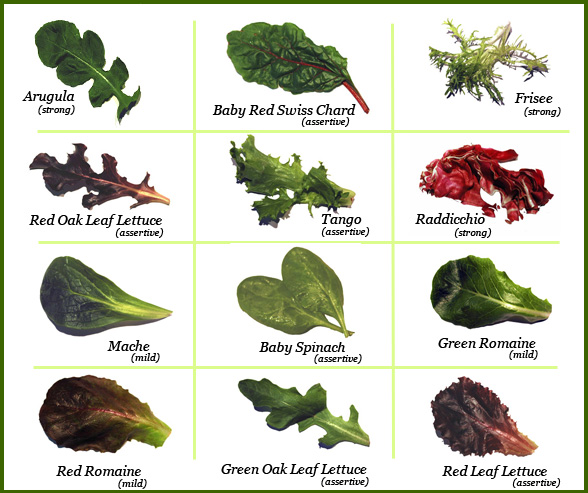 |
Dress It Up |
Good greens like to dress up for the occasion. As tasty as they are on their own, it's the marriage of greens with dressing that make for the full salad experience. Salad dressings can be generally classified into three types: (1) Vinaigrettes (oil and vinegar-based), (2) Mayonnaise-based, and (3) Dairy-based (sour cream, buttermilk, or cream). A great dressing provides an essential layer of flavor in a concentrated form that accentuates the salad and brings out the best of the fresh produce without overpowering the moment. We'll focus here on vinaigrettes. The Magic Ratio for Vinaigrettes - We're fondest of oil and vinegar variations because they allow the greens' flavor and appearance to shine on the plate and in the mouth. Vinaigrettes sport an oil to vinegar ratio of 3:1, three parts oil for every one part vinegar. From this classic formula, any number of combinations and additions serve to shape the vinaigrette's personality. The Magic Ratio for Vinaigrettes - We're fondest of oil and vinegar variations because they allow the greens' flavor and appearance to shine on the plate and in the mouth. Vinaigrettes sport an oil to vinegar ratio of 3:1, three parts oil for every one part vinegar. From this classic formula, any number of combinations and additions serve to shape the vinaigrette's personality.Choosing the Oil - Aficionados recommend using a neutral-to-lightly flavored oil for salads. Neutral oils include canola, soy, or safflower oil. 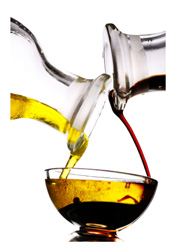 Our favorite, of course, is olive oil. Use only extra-virgin olive oil, the oil from the first pressing of the olives, for salads. The delicate flavor is a perfect foil for most salads. Save strongly flavored oils such as walnut, sesame, or chili, as accents in the dressing. Our favorite, of course, is olive oil. Use only extra-virgin olive oil, the oil from the first pressing of the olives, for salads. The delicate flavor is a perfect foil for most salads. Save strongly flavored oils such as walnut, sesame, or chili, as accents in the dressing.What is Vinegar? - Vinegar is the naturally occurring result of two fermentation processes. Sweet liquids undergo a first fermentation process where yeast breaks down the sugars into alcohol. The second fermentation uses Acetobacter bacteria to breakdown the alcohol into acetic acid. To be a vinegar, there must be at least 4% acetic acid in the liquid. 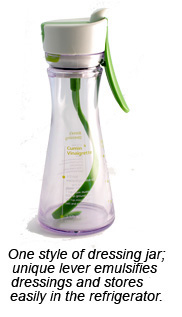 However, water and acetic acid do not make vinegar; rather, it is the original fruit's character, flavor, vitamins, and minerals that give vinegar its taste and character. We are most familiar with vinegars made from apple juice and grape juice, though any plant with sugars can become vinegar. For example, malt vinegar, the British standard, is made from germinated grain. However, water and acetic acid do not make vinegar; rather, it is the original fruit's character, flavor, vitamins, and minerals that give vinegar its taste and character. We are most familiar with vinegars made from apple juice and grape juice, though any plant with sugars can become vinegar. For example, malt vinegar, the British standard, is made from germinated grain.Mixing Vinaigrettes - Oil and water don't mix, we know that. For salad dressings, the oil and water is shaken or stirred enough so that a temporary emulsion is achieved and salads evenly dressed. Three common kitchen tools make great dressings: whisk, food processor, or blender. Our mini-food processor is particularly nice for chopping the garlic and shallots first prior to adding the vinegar and oil. 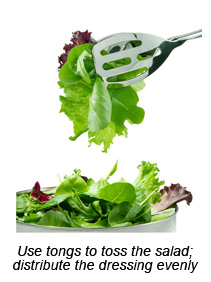 Whatever your tool of choice, make the dressing in glass or stain-resistant plastic containers with stainless steel utensils. Aluminum vessels and utensils will react with the vinegar leaving a metallic taste. Mix all of the dressing ingredients, except the oil, and blend thoroughly. Slowly drizzle the oil into the vinegar base while whisking or processing. The tiny hole in the feed tube of your food processor is made especially for the gradual addition of oil. Whatever your tool of choice, make the dressing in glass or stain-resistant plastic containers with stainless steel utensils. Aluminum vessels and utensils will react with the vinegar leaving a metallic taste. Mix all of the dressing ingredients, except the oil, and blend thoroughly. Slowly drizzle the oil into the vinegar base while whisking or processing. The tiny hole in the feed tube of your food processor is made especially for the gradual addition of oil.Toss and Serve - Immediately before serving, drizzle the dressing over the freshly prepared greens. Ensure that the greens are dry or the dressing will not adhere to the leaves' surfaces. With salad utensils, toss so that all of the greens are evenly coated with the dressing. A vinaigrette dressing has the effect of wilting the salad in a very short time, so serve and enjoy immediately. |
Season to Taste |
|---|
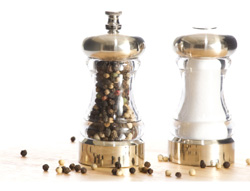 Green salads host the perfect occasion for finishing with salt and pepper. Not only are salt and pepper a great flavor addition, they add a visual touch and, potentially, a little culinary performance art. Here are some quick definitions and tips on "seasoning to taste." Green salads host the perfect occasion for finishing with salt and pepper. Not only are salt and pepper a great flavor addition, they add a visual touch and, potentially, a little culinary performance art. Here are some quick definitions and tips on "seasoning to taste."Salt - This ubiquitous seasoning is simple sodium chloride, yet comes in many forms that will impact your cooking life: Table salt - This salt is very fine grained and is generally mined from salt deposits. Table salt is available in iodized or non-iodized forms. Unless specified otherwise, recipes calling for salt refer to table salt. Kosher salt - This salt is larger grained and typically without additives. The larger grains do not dissolve as readily as table salt providing certain advantages in various cooking situations. Because of the larger grains, one teaspoon of kosher salt is half to one-third as potent as one teaspoon of table salt. If substituting kosher salt, measure by weight instead of volume. Sea salt - Derived from evaporated seawater, sea salt has the advantage of micro-flavors from minerals of the region. Specialty salts are perfect for finishing salads where they willing bloom and are showcased to perfection. We'd be happy to walk you through the different choices of finishing salts. 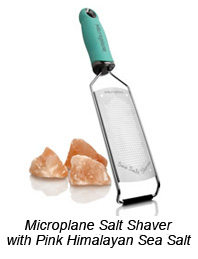 Pepper - Married with salt forever, freshly ground pepper on a salad complements the greens and the dressing. Unrelated to chili peppers, peppercorns are dried fruits that when ground, release piperine compounds that stimulate our taste buds. The potency of pepper evaporates quickly when exposed to air, so grind peppercorns just before using. Shakers, Shavers, and Grinders - One of our favorite gifts for newlyweds is a quality salt and pepper set. We have many choices that are truly works of art ready to grace any table. Salt shavers are unique tools that transform a chunk of salt into small flakes as a finishing step. Never put salt in a pepper grinder, or vice versa - each device is specially made for its designated contents. |